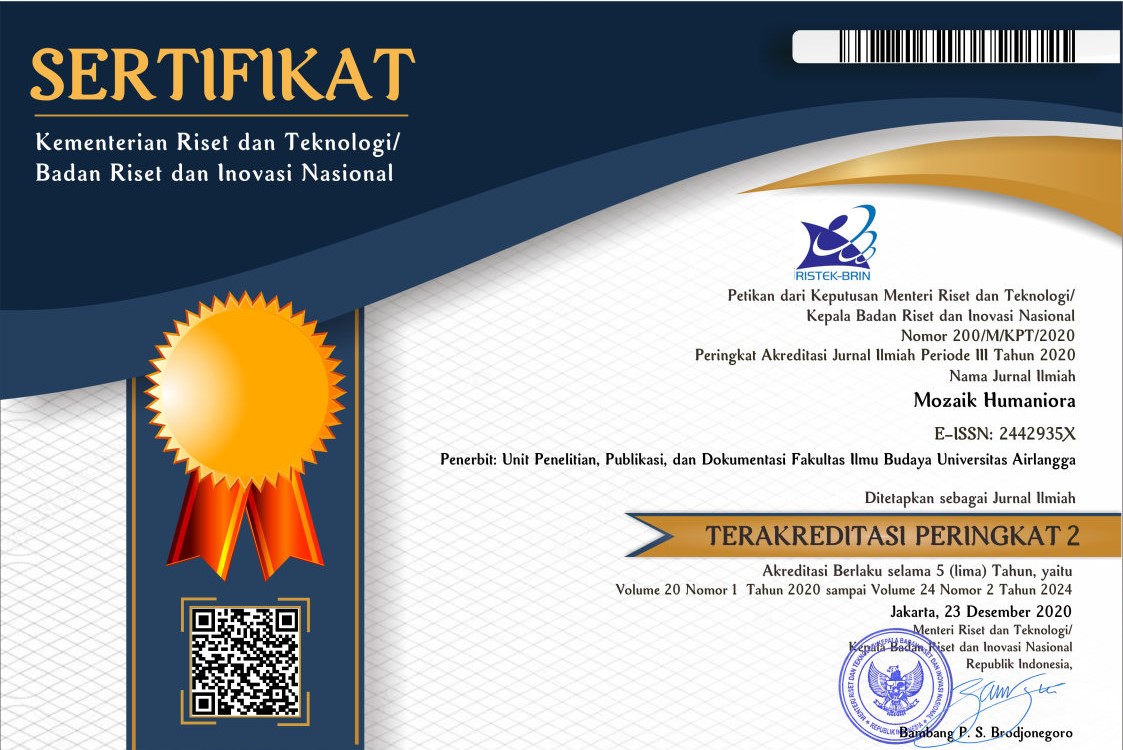Language and Style of Communication of Samin Community in Kudus, Central Java
Downloads
This study aims to find out the style of language and communication used by the Samin Karangrowo community with their fellows and others outside the community. The Samin community, located in Karangrowo Village, Undaan District, Kudus Regency, is assumed to have unique style of language and communication due to their different attitude, behavior, and social conditions compared to others in Kudus Regency. Qualitative method with ethnographic approach is used in this study. This study then reveals that Samin Javanese language is mostly used in the Samin Karangrowo community. This study also finds out that Jawa ngoko and krama inggil are mostly used by the Samin people to communicate with others outside their community. Besides, the results of this study indicate that equalitarian style is frequently used by the Samin Karangrowo community as their communication style with their fellows since it is considered to be very effective for them in making decisions wisely as well as in solving their problems. However, in communicating with others outside the community, they mostly use controlling style as their communication style to protect the customs and culture of the Samin community from outside cultures. Finally, it can be concluded that the Samin community is strongly upholding the teachings of Sedulur Sikep in their communication strategy.
Daeng, Hans J. 2012. Manusia Kebudayaan Lingkungan Tinjauan Antropologis. Yogyakarta: Pustaka Pelajar.
Fajrie, Mahfudlah. 2016. Budaya Masyarakat Pesisr Wedung Jawa Tengah. Wonosobo: CV Mangku Bumi Media.
________. 2017. "Gaya Komunikasi Masyarakat Pesisir Wedung Jawa Tengah.” INJECT: Interdisiplinary Journal of Communication 2 (1): 53”76.
Fauzia, Amelilia & Yohanis F. Kahija. 2019. "Arti Memelihara Tradisi pada Suku Samin, Interpretative Phenomena Logical Analysis.” Jurnal Empati 8 (1): 228”237.
Hariyana. 2009. Komunikasi dalam Organisasi. Paper. Depok: Faculty of Social and Political Sciences, Indonesia University.
Hidayati, Nur Alfin & Siti Aniqoh Shofwan. 2019. "Identitas Karakter Budaya Masyarakat Samin di Desa Margomulyo Bojonegoro.” Jurnal Kredo 3 (1): 56”61. DOI: https://doi.org/10.24176/kredo.v3i1.4020
Huda, Khoirul & Anjar Mukti Wibowo. 2013. "Interaksi Sosial Suku Samin dengan Masyarakat Sekitar (Studi di Dusun Jepang Desa Margomulyo Kecamatan Margomulyo Kabupaten Bojonegoro).” Jurnal Agastya 3 (1): 127”148.
Koentjaraningrat. 2015. Pengantar Ilmu Antropologi. Jakarta: PT Rineka Cipta.
Lauer, Robert H. 2003. Perspektif tentang Perubahan Sosial. Jakarta: Rineka Cipta.
Miles, Matthew & A. Michael Huberman. 2009. Analisis Data Kualitatif. Jakarta: UI Press.
Mumfagati, Titi. 2004. Kearifan Lokal di Lingkungan Masyarakat Samin Kabupaten Blora Jawa Tengah. Yogyakarta: Jarahnitra.
Octaviani, Emilia Vinna. 2015. "Pola Komunikasi Suku Samin di Kabupaten Blora Terkait Ajaran yang Dianutnya.” The Messenger 7 (2): 26”29.
Pawito. 2007. Penelitian Komunikasi Kualitatif. Yogyakarta: Pelangi Aksara.
Pinasti, V. I. S. & Puji Lestari. 2017. "Masyarakat Samin Ditinjau dari Sejarah dan Nilai-nilai Pendidikan Karakter.” Istoria; Jurnal Pendidikan dan Sejarah 13 (2). DOI: https://doi.org/10.21831/istoria.v13i2.17737
Purwasita, Andrik (ed). 2003. Agama Tradisional. Yogyakarta: Lkis.
Roeslan, Rosady. 2005. Kampanye Public Relation. Jakarta: PT Raja Grafindo Persada.
Rosyid, Moh. 2008. Samin Kudus: Bersahaja di Tengah Asketisme Lokal. Yoyakarta: Pustaka Pelajar.
________. 2014. "Memotret Agama Adam: Studi Kasus Pada Komunitas Samin.” Orientasi Baru 23 (2): 189”210.
Setyaningrum, Dewi, Tri Marhaeni Puji Astuti, and Moh. Yasir Alimi. 2017. "Pergeseran Nilai Masyarakat Samin (Sedulur Sikep) Dukuh Bombong”. Journal of Educational Social Studies 6 (1): 29”36. DOI: 10.15294/JESS.V6I1.16252
Suneki, S. 2012. "Dampak Globalisasi terhadap Eksistensi Budaya Daerah.” Jurnal Ilmiah CIVIS 1 (2): 307”321.
Widjaja. 2000. Komunikasi dan Hubungan Masyarakat. Jakarta: Bumi Aksara.
Wiryanto. 2004. Pengantar Ilmu Komunikasi. Jakarta: PT Grasindo.
Copyright (c) 2022 Mahfudlah Fajrie

This work is licensed under a Creative Commons Attribution-ShareAlike 4.0 International License.

Mozaik Humaniora is licensed under a Creative Commons Attribution-ShareAlike 4.0 International License. Both authors and Mozaik Humaniora agree with the following attribution of journal:
1. Copyright of this journal is possession of Author, by the knowledge of the Editorial Board and Journal Manager, while the moral right of the publication belongs to the author.
2. The journal allows the author(s) to retain publishing rights without restrictions
3. The legal formal aspect of journal publication accessibility refers to Creative Commons Attribution Share-Alike (CC BY-SA).
4. The Creative Commons Attribution Share-Alike (CC BY-SA) license allows re-distribution and re-use of a licensed work on the conditions that the creator is appropriately credited and that any derivative work is made available under "the same, similar or a compatible license”. Other than the conditions mentioned above, the editorial board is not responsible for copyright violation.


















